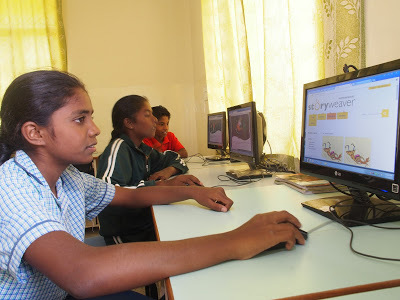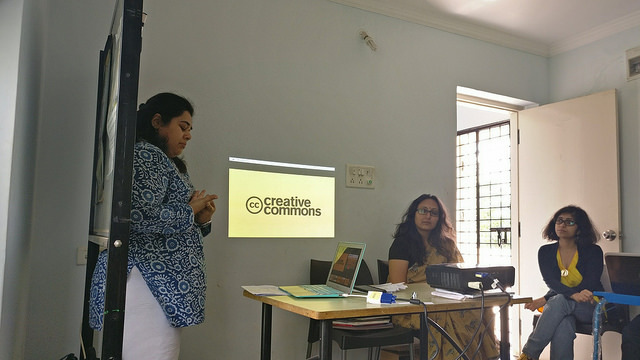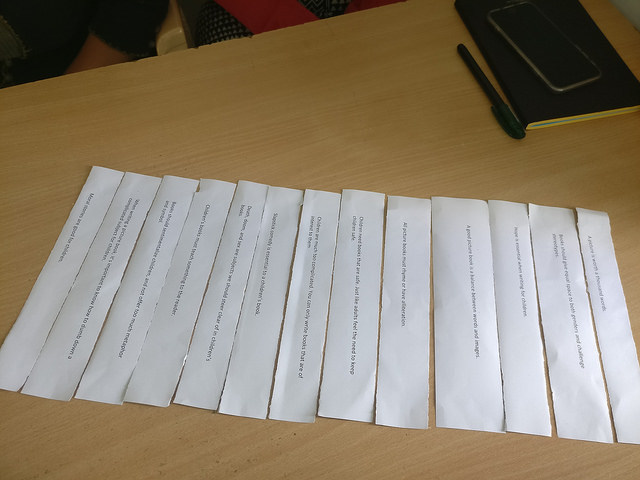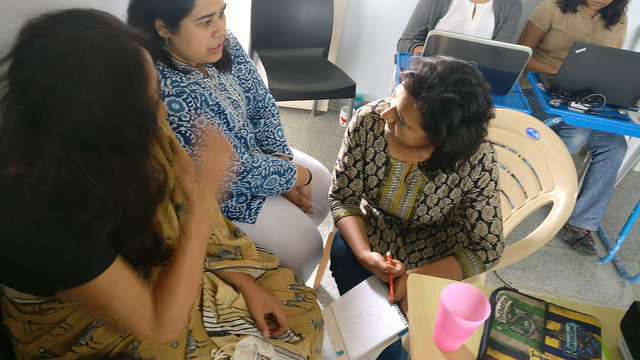कुछ अनुवाद जिन्होंने पूरी दुनिया ही बदल दी
Posted by Amna Singh on October 11, 2016Madhu B. Joshi prefers to be known as a communication practitioner. She sees a great need for demystification in daily life and has been trying to work towards it. She has taught translation and a short, self-designed course of Indian Culture; mentored content teams of major education NGOs and designed educational audio-video programmes for CIET, NCERT. Joshi is a translator of Hindi poetry and short fiction in English and has presented major black feminist writers in Hindi. She is also a prolific and visionary collaborator of StoryWeaver. All of this, and we also know and love the other मधु बी. जोशी (in her own words)... जो खाना पकाना, इलाज करना, पौधे और कुत्ते पालना, राय देना.. जैसे बहुत से मुफ़्त काम करती हैं। उन्हें सब से ज़्यादा मज़ा बच्चों के लिए काम करने में आता है और वह इसका कोई मौका नहीं चूकतीं।
Here, we re-present an article of hers that was carried in Hindustan on International Translation Day (30th Sept). In this article, she gives us historical evidence to emphasize the power of translations. She talks about how translations of key religious texts helped break religious barriers and induce world peace in the strife ridden political milieu of the 16th Century.
अनुवाद के धर्म के चेहरे को बदलने और उसे अधिक लोकोन्मुख और सर्वसुलभ बनाने के दो बड़े उदाहरण हैं रामायण और बाइबल के 16वीं सदी में आए संस्करण। इन ग्रंथों ने अपनी भाषा और युग को नए शब्द, नए मुहावरे और नई अवधारणाएं ही नहीं दीं, सामाजिक और राजनीतिक बदलाव की प्रक्रिया को भी प्रभावित किया। कम से कम यूरोप में तो इन के बाद लेखन का तेवर पूरी तरह बदल गया। आज अगर धर्म पर सार्वजनिक बहस संभव है तो उसकी पीठिका इन्हीं अनुवादों ने तैयार की है।
बाइबल के शुरूआती जर्मन और अंग्रेज़ी अनुवाद करने वाले मार्टिन लूथर और विलियम टिंडेल हिब्रू-ग्रीक और लैटिन जैसी शास्त्रीय भाषाओं के अधिकारी विद्वान और धर्मशास्त्री थे (बाइबल के उनके अनुवाद इस ग्रंथ के हिब्रू-ग्रीक पाठों पर आधारित थे) तो रामायण का पुर्नपाठ करने वाले तुलसीदास संस्कृत के अधिकारी विद्वान और धर्मशास्त्री थे। लेकिन अपने युग और समाज के लिए, अभी तक अभिजातवर्ग तक सीमित रहे और ज्ञान के समानार्थक बन चुकेशास्त्रीय ग्रंथों को लोक के लिए सुलभ बनाने के लिए उन्होंने घर-गली-बाज़ार की भाषा को आधार बनाया। तुलसीदास ने काव्यरचना की तत्कालीन भाषा ब्रजभाषा के बजाय अपने क्षेत्र की लोकभाषा अवधी में रामचरितमानस लिखा।
यह अनुवाद धर्मविरूद्ध माने गए। आखिर वह धर्मग्रंथों के एक वर्गविषेश द्वारा ही लिखे-पढ़े और व्याख्या किए जाने की परंपरा से ज़बर्दस्त विचलन थे। यूरोप में तो यह चर्च और उस के समर्थन से चल रही राजा की सत्ता को बड़ी चुनौती थे। मार्टिन लूथर का साथ उनके अनुयायियों ने तक छोड़ दिया, विलियम टिंडेल के अनुवाद की प्रतियां राजादेष पर जलाई गईं, खुद उन की हत्या की गई, तुलसीदास और रामचरितमानस काषी के विद्वतवर्ग का कोपभाजन बने रहे।
इन तीनों अनुवादों ने अभिजातवर्ग का विषेशाधिकार बन चुके शास्त्रीय ज्ञान को जनसाधारण के लिए सुलभ बना कर विषेशाधिकार और ज्ञान पर एकाधिकार को एक झटके में तोड़ दिया। दरअसल इस आंदोलन की शुरूआत पहले ही जर्मन बोलियों में लैटिन स्त्रोतों के अनुवाद और भारतीय बोलियों में भक्ति और ज्ञान के पदों की रचना से हो चुकी थी। इनमें से बहुत सी रचनाओं में विचार के स्तर पर शास्त्रीय धर्मग्रंथों की अनुगूंज सुनाई देती है लेकिन सच यह भी है कि इनके रचनाकार, कम से कम भारत में, ज़्यादातर परंपरागत शास्त्रीय ज्ञान से दूर रखे गए वर्गों से थे। यह सभी रचनाएं पुरोहित वर्ग के दान-दक्षिणा-प्रायश्चित-अनुष्ठान को मुक्ति का साधन बताने के विरूद्ध स्वर उठाते हुए मनुष्य के व्यक्तिगत कर्म को, मनुष्य के देवताओं को समर्पण के बरक्स मनुष्य के जीवमात्र के प्रति करूणाभाव को सर्वोच्च मान रही थीं जिससे पुरोहित की ज़रूरत और वैधता ही संदेह के दायरे में आ गई। जीवमात्र के प्रति करूणाभाव कोई नई अवधारणा नहीं थी। ईसाई संत फ्रांसिस और बुद्ध ने करूणा का उपदेश बहुत पहले दिया ही था लेकिन पुरोहितवर्ग ने उसे ईश्वर और ईसा का विषेश लक्षण बना दिया था।
यूरोप में बाइबल के अनुवादों को यूरोप की राजसत्ताओं पर रोमन कैथॅलिक चर्च की कड़ी जकड़ को तोड़ने वाली घटना माना जाता है जिसने आखिर अरब, ईसाई और मुसलमान सेनाओं के बीच चलनेवाले धर्मयुद्धों को लगभग खत्म कर दिया। रामचरितमानस और भक्ति काव्य ने हिंदू धर्म के आधार, चतुर्वर्ण की अवधारणा पर पुनर्विचार किए जाने की ज़रूरत को रेखांकित किया और यह क्रम अब भी जारी है।

Read Madhu B Joshi's happy translations on StoryWeaver here. One World, that's the eternal dream!
Be the first to comment.Hello Hyderabad! Pratham Books is conducting a StoryWeaver workshop!
Posted by Remya Padmadas on February 13, 2017Pratham Books is conducting a special workshop on StoryWeaver - an open source, digital repository of multilingual children’s stories.
The workshop will be held in Hyderabad on 22nd and 23rd February,2016. (Wednesday-Thursday) (You can attend it any one day).
The workshop would cover the following
1. A detailed Demo of StoryWeaver – how to navigate and use the platform
2. Examples of how educators are using StoryWeaver effectively in their classrooms
3. Dedicated work time for participants to try their hands on StoryWeaver
4. An opportunity to meet people from similar fields and make interesting conversations
(Read about previous StoryWeaver workshops here and here.)
So if you are:
- a librarian or resource lead looking to curate stories
- an educator in search of interesting ways to introduce concepts to your students
- a storyteller or a reading champion
- someone passionate about children's storybooks in Indian languages ...

Please note that the seats are limited and only confirmed participants will get a separate email confirming their participation, date of attendance and other logistical details.The workshop will be held at Madinaguda, Chandanagar- Hyderabad between 11 a.m to 4 p.m. There is no charge to attend the workshop.
We look forward to seeing you! If there are any queries, please email us at [email protected]
Be the first to comment.Carnivorous plants, jumping spiders and misunderstood wolves: just another day at NCF, India!
Posted by Remya Padmadas on July 27, 2017Aparna Kapur, Assistant Editor, Pratham Books recalls our recent writing workshop with conservationists and research scholars at the Nature Conservation Foundation, India.
I’m less than two months old in Pratham Books and have heard all about the various writing, translating, outreach workshops conducted by the team. So when I was asked if I wanted to tag along to a workshop about making Level 1 and Level 2 picture books, I was keen to observe and said yes immediately. Of course, the luxury of silent observing was not given to me and I was assigned an activity to conduct. Trying to create an illusion of choice, I happily agreed.
The workshop was being conducted for the members of the Nature Conservation Foundation. The NCF office is located on a quiet street that’s lined with trees, and when we walked in we were immediately met with the bustle of breakfast time. We were then ushered into a room, which would soon contain eleven workshop participants and four workshop conductors. Once we figured out the logistics of seating (the view was beautiful but the room was snug) and the mechanics of projecting (acquiring the right wire), we were ready!
As way of introduction, we went around the room telling everyone who our favourite children’s book character is, which is how I think we all should introduce ourselves from now on.
Then we talked about Pratham Books and picture books, and read out some titles from StoryWeaver. This was followed by a quick tour of the StoryWeaver website where we showed them how to browse the site, search for images and create books. The NCF folk were involved and enthusiastic.

This was followed by a coffee break where everyone got to enjoy the generous collection of picture books that Bijal Vachharajani, Consultant Editor, Pratham Books had brought along. After coffee, we divided the eleven of them into groups for the first activity. Each group was given a list of rules for making a picture book, and had to arrange them in the order they considered most important. This led to some fascinating debates about the balance of text and images, the necessity of morals and optimism, and the need for rhythm and rhyme.

After that we told the groups to come up with a simple story based on eight random pictures. We had delightedly strung an outlandish sequence of pictures the previous day, and this served as their framework. Each time we moved to the next picture, the teams let out a groan and we smiled in (evil) satisfaction. The three stories we got at the end of it, however, were amusing and coherent. That’s when I realised that each of these eleven people had a knack for storytelling!
My realisation was confirmed when we they began to think of ideas. Considering their work, we did expect interesting environmental themes. But we were an excited group of editors when their pitches included carnivorous plants, geckos, and misunderstood wolves!
After a well-earned lunch, we all went back to work. And by all, I mean the NCF people worked on the drafts of their stories while we sat like invigilators, reading their drafts and occasionally helping them find their way out of tricky spots in their manuscripts.

Finally, everyone read out their stories. Some employees who were not attending the workshop had given us explicit instructions to invite them for the idea-sharing and storytelling part of the workshop. They ended up being a participative and enthusiastic audience. We trust that this workshop gave the NCF team a foundation on which they will go on to write many many picture books. In return they gave us some fantastic ideas and superb stories!
Be the first to comment.